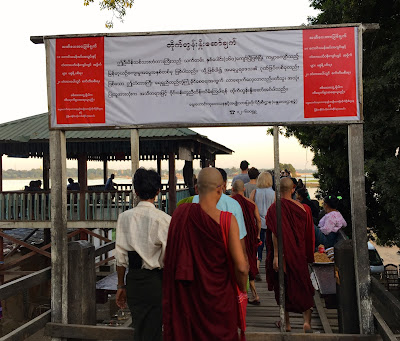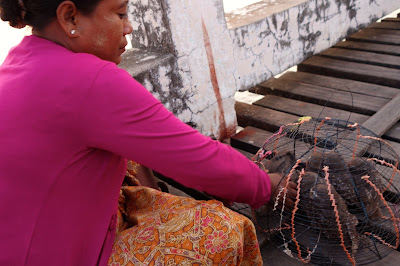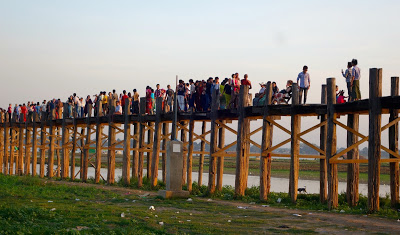It’s now late in the afternoon and time to cross back over the Ayeyarwaddy river, to head to Lake Taung Thaman where we can walk the world’s longest teak bridge, the U Bein Bridge, for atmospheric sunset photos.
The drive through Amarapura to get to the bridge was interesting. Burma is a land of extremes, and on our drive through, we got to see some strikingly impoverished dwellings. This is the little village, and this is all these folks have. I took these pics from the moving car.
As we got closer to the bridge area, we passed by a workshop where they must be preparing silk thread for weaving. It made for a strikingly colorful picture. Most of the residents here earn their living in workshops that specialize in making fine-quality longyis and htameins for weddings. In fact, the distinctive sound of looms at full tilt is a constant soundtrack.

The bridge is a must-see. It stretches more than 1200 meters across the lake. It also hosts the world’s longest unbroken line of tourists, which actually isn’t bad, as the colors of everyone’s shirts, lit up by the sun’s last rays, make quite the spectacle. Here’s the entrance. Our guide, who’s probably walked this bridge a thousand times, hung out in the parking lot with the driver, while Mark and I joined the throng. The parking lot was actually pretty interesting, filled with souvenir shops, restaurants, and snack stalls that are always busy with visitors not just from Burma, but other countries as well. Like us.

There were a lot of monks on the bridge, as you can see.
The number of visitors to the lake and the bridge has increased every year. During high stepson, tourist arrivals to the bridge is from 1000 to 1200 a day.
As you’re walking out on the bridge, the lake is on your right. We looked down and saw an oxen cart below.

More about the bridge: The U Bein bridge was actually made as a salvage job that occurred after one of Myanmar’s many changes of regal power. When the palace was moved north to Mandalay, in 1859, the mayor of Amarapura (his name was U Bein) decided to create a bridge using the teak support columns left behind. Some have been replaced by concrete poles. Not a single nail was used in the construction. Today, there are just over 1000 pillars along the course of the bridge. The bridge is purposely curved to lessen the impact of storms and the annual floodwaters.
For nearly a century and a half, it has allowed farmers, fishermen and monks to pass from one shore to the other. It was built so high above the lake because the water level rises considerably after the rains during the monsoon season. The bridge is one of the most iconic and most photographed sights in Burma.
The atmosphere on the bridge is active and lively. Lots of people taking photos, studying the architecture of the bridge, and gazing out at the scenery.
Glancing left and right, you see some truly picturesque sights on the shimmering water. The surface of the lake gets nicely rippled when there’s a gust of wind. Taung Thaman Lake was believed to have existed in the lifetime of the Buddha and was named after one of four ogres when Buddha was alive. I think this is what draws monks to come here.

Boats can be seen on the water. Like the historical bridge itself, the boatmen from the lake are another contributing factor making this place so popular. In spite of the fact that a boat can carry 15 passengers at maximum, they are allowed to cary just five locals and two foreigners, for safety reasons. There are about 50 boats around the lake, charging about 5000 kyat ($4) for locals and 10000 kyat ($8) for foreigners. I imagine photos of the bridge, taken from the boats, are amazing.



Saw an interesting sight. A woman on the bridge had a small cage containing several owls. For about $4, you can pick out and owl and set it free. This is considered a good deed, and it earns you “merit”, which is important to Buddhists. They conveniently forget the brutality of capturing and imprisoning the owls in the first place.
 I could stare out at the boats on the water all day.
I could stare out at the boats on the water all day.
This is one of four pavilions where passersby can take a rest on the benches, to enjoy the lake scenery.
We continued on for another couple of hundred feet, and then turned back to capture the sunset. this is when the bridge is the most crowded, in late afternoon. Not much more narration needed here.
And a few final photos of the people on the bridge, as the sun begins to fade…
Our visit to Amarapura was done. We headed into Mandalay, and checked into the Bagan King Hotel on the corner of 73rdStreet and 28th road. Tomorrow

I could stare out at the boats on the water all day.


